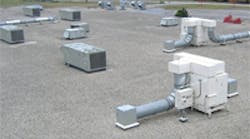As rising energy costs have crept to the forefront of concerns for plant managers, those that oversee facilities that vent smoke and other dirty air from welding and cutting operations are faced with particularly higher costs.
Venting air outside, and having to replace it from heated and air conditioned systems, means higher gas and electric bills, especially on a seasonal basis.
But a promising new approach is in development that favors applicationspecific, turnkey systems that filter air at the source of generation, focusing at a modular level instead of plant-wide needs.
Point-of-source systems return air to within the building, thereby reducing expenses associated with “make-up” air, helping to slash gas and electric costs.
Considering that plants located within air-quality districts often require less permitting by not venting polluted air, and that modular systems involve almost zero footprint, and no extensive ducting to install, the arguments for investigating this money-saving option are convincing.
The need for smoke removal from manual and robotic welding and cutting, laser and plasma cutting, machining, grinding, and polishing is an ongoing issue for metal suppliers and fabricators.
Traditionally, facilities that produce smoke or oil mists often collect and exhaust the dirty air to the outside with massive roof-mounted blowers connected through a maze of ductwork from welding areas.
“Any dumping of heated or cooled air to the outside is done at great expense,” says Fergie Haughton, systems sales manager at Clean Air America Inc., a provider of turnkey point-of-source filtration systems for robotic integrators and integrators of laser cutting and plasma cutting tables.
“Whether it’s zero or 97 degrees outside, bringing in ‘make-up’ air at any volume above 50% is very costly,” says Haughton. “Some plants run 80% to 90% make-up air, and that not only throws money out the window but it forces the HVAC system to work extremely hard.”
Rather than taking an expensive “shotgun” approach by managing air filtration on a plantwide basis, some facility managers are starting to target air filtering efforts to only those areas that require them.
“Heating and air conditioning costs are about $2.00 cfm and $4.00 cfm, respectively, at our plant,” says Glen Tuplin, facilities manager at F&P Georgia, a manufacturer of subframe and suspension components for Honda and Nissan, which runs extensive welding, stamping and painting operations.
While the original F&P plant was built in 2001 with a traditional ventilation system, when the plant was expanded in 2003 Tuplin opted to retrofit a new air-filtration system that consists of modular hoods for welding cells and dust collectors to filter and return the air instead of exhausting it to the outside.
“Our exhaust total air volume is 103,000 cfm, and because the Clean Air system filters and returns plant air, it was simple math to see that we could save $200,000 annually with their system,” says Tuplin. “This strategy has really paid off. I believe the payback on our system was about one year, something that our own engineers and management would hardly believe.”
Smoke, grinding dust, oil mist and other production pollutants are collected and cleaned efficiently through modular air filtration systems that often comprise a completely self-contained work center for welding and cutting. No ducting is necessary, and all of the filtering apparatus sits above the welding area so that zero footprint is taken from the production floor.
Using down-flow filtering technology accounts, in part, for some of the efficiency of these modular systems. Incoming dirty air flows downward through filters positioned vertically—as opposed to an angle—to readily shed dust such as found within welding smoke. The filters trap most of the small particles while larger ones fall into a dustsettling hopper. A jet-pressure wave cleans the system’s row of filters, further propelling trapped dust to move downward into the hopper.







